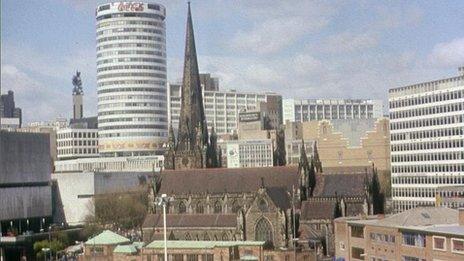How Birmingham changed following World War II
- Published

The landscape of Birmingham is constantly changing
The aftermath of the bombings of World War II have had an impact on the landscape of many UK towns and cities.
But it was one wartime experience, and view, that inspired a Birmingham architect to create the Grade II listed Rotunda building - the familiar circular fixture of the city's skyline.
Jim Roberts, who was born in Kings Heath, Birmingham, took inspiration for the height of the building from the views he witnessed while manning an observation post as a member of the Home Guard.
Mr Roberts remembers: "I manned the Council House clock in Birmingham and could see Coventry during the Blitz. There was a red horizon, a terrible sight.
"Because I'd seen the view from the clock tower, I pushed for the Rotunda to go higher."
Another architect of the mid-20th Century was Sir Herbert Manzoni, the city engineer and surveyor of Birmingham from 1935 until 1963, who was responsible for much of the city's post-war landscape.
As well as creating the ring road, he also launched a slum clearance scheme and built tower blocks in response to a serious housing shortage in Birmingham.
Over the next few years, Birmingham will have a modern New Street station and a new library as a number of different areas of the city are regenerated.
Growth of Rotunda
Mr Roberts, who was also behind the Ringway Centre and the former Albany Hotel in Birmingham, wanted a circular building to be a focal point of the new ring road.
He said: "We started with a little stubby thing of about 12 storeys high, but then it gradually grew into what we know now.
"Originally the final design for the Rotunda was to have a revolving restaurant at the top, but they decided that there wasn't enough money in that."
After being used as offices for decades, a few years ago,the Rotunda was given a new lease of life, externaland was turned into apartments.

The Rotunda survived the 1974 Birmingham pub bombings
Mr Roberts worked with the architects and developers to bring the building into the 21st Century.
He said: "I had the wonderful opportunity to make the Rotunda what I originally wanted to make it.
"It's just like I would have liked to have done with it in the 1960s, probably. Unfortunately the developers then were so tight on finance, even the windows were so cheap that in a storm they would blow open."
This building is just one example of how redevelopment can be for the better - and in this case, bring improvements to the original building.
However, through the years, many buildings have been lost due to development.
'A little town'
Mr Roberts, who is also a town planner, said: "A lot of damage was done to Birmingham which wasn't all due to the bombing.
"The ring road did a lot of damage and he [Sir Herbert Manzoni] knocked some buildings down that should have been preserved and should still be in Birmingham.

The Bull Ring Centre was the first indoor city-centre shopping centre in the UK
"People seem to have forgotten almost that Birmingham was the little town with the church in the centre."
When developing the 1960s Bull Ring Centre, Birmingham City Council used material from designs by Mr Roberts.
The Bull Ring Centre eventually made way for today's Bullring.
Mr Roberts commented on the closeness of the shopping centre to St Martin's Church, saying: "Birmingham planners allowed a little tiny churchyard to be developed on.
"They should have been more interested in conservation and preservation and pushed that away a bit, but otherwise it's perceived as very good indeed."
- Published10 April 2012
- Published1 March 2012
- Published5 October 2011
- Published21 June 2011
- Published11 January 2012
- Published20 March 2012
- Published15 August 2011
- Published16 February 2012
- Published28 March 2011